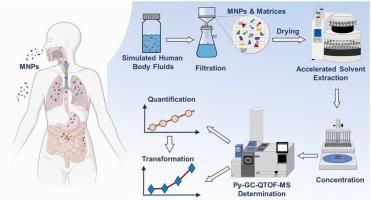微、纳米塑料在模拟人体体液中转化的定量跟踪
IF 11.3
1区 环境科学与生态学
Q1 ENGINEERING, ENVIRONMENTAL
引用次数: 0
摘要
微塑料和纳米塑料(MNPs)广泛存在于环境和食物中,通过各种途径构成摄入风险。然而,由于定量方法的不足,它们在人体体液中的转化,特别是次级纳米颗粒的形成,还没有得到很好的理解。本研究提出了一种采用加压液体萃取(PLE)预处理和热解气相色谱-四极杆飞行时间质谱(Py-GC-QTOF-MS)分析8种常见MNPs的可靠方法。该方法回收率达90.9%以上,检出限低至0.01 mg/L。大多数样品基质不干扰MNP定量,尽管聚(3-羟基丁酸酯)和聚乙烯需要扣除背景噪声。SBFs的高回收率(>79.0%)进一步证实了该方法的实用性。利用该方法发现,只有少数MPs能够在模拟消化系统中释放次生NPs,释放的NPs最大比例小于2.1%,表明次生NPs的健康风险可以忽略不计。此外,酯结构并不促进次级NPs的形成,但对表面形貌和官能团有一定的影响。我们预计,这项工作将为评估移徙者的健康风险提供机会。本文章由计算机程序翻译,如有差异,请以英文原文为准。

Quantitative tracking of the transformation of micro- and nanoplastics in simulated human body fluid
Micro- and nanoplastics (MNPs) are widespread in the environment and food, posing ingestion risks through various pathways. However, their transformation in human body fluids (SBFs), especially the formation of secondary nanoparticles (NPs), is not well understood due to inadequate quantification methods. This study proposed a robust method for quantifying eight common MNPs using pressurized liquid extraction (PLE) for pretreatment and pyrolysis gas chromatography-quadrupole time-of-flight mass spectrometry (Py-GC-QTOF-MS) for analysis. The method demonstrated high performance with recoveries over 90.9 % and a detection limit down to 0.01 mg/L. Most sample matrices did not interfere with MNP quantification, though poly(3-hydroxybutyrate) and polyethylene required background noise deduction. High recoveries in SBFs (>79.0 %) further confirmed the practicality of this method. Utilizing this method, it was found that only a few MPs were able to release secondary NPs within the simulated digestive system, with the maximum proportion of released NPs less than 2.1 %, suggesting a negligible health risk from secondary NPs. Besides, ester structure was found not to promote the formation of secondary NPs but did affect surface morphology and functional groups to a certain extent. We anticipate that this work will open opportunities for the health risk assessment of MNPs.
求助全文
通过发布文献求助,成功后即可免费获取论文全文。
去求助
来源期刊

Journal of Hazardous Materials
工程技术-工程:环境
CiteScore
25.40
自引率
5.90%
发文量
3059
审稿时长
58 days
期刊介绍:
The Journal of Hazardous Materials serves as a global platform for promoting cutting-edge research in the field of Environmental Science and Engineering. Our publication features a wide range of articles, including full-length research papers, review articles, and perspectives, with the aim of enhancing our understanding of the dangers and risks associated with various materials concerning public health and the environment. It is important to note that the term "environmental contaminants" refers specifically to substances that pose hazardous effects through contamination, while excluding those that do not have such impacts on the environment or human health. Moreover, we emphasize the distinction between wastes and hazardous materials in order to provide further clarity on the scope of the journal. We have a keen interest in exploring specific compounds and microbial agents that have adverse effects on the environment.
 求助内容:
求助内容: 应助结果提醒方式:
应助结果提醒方式:


